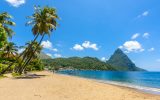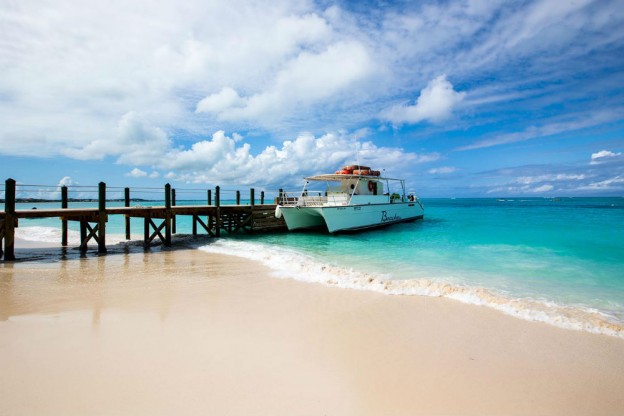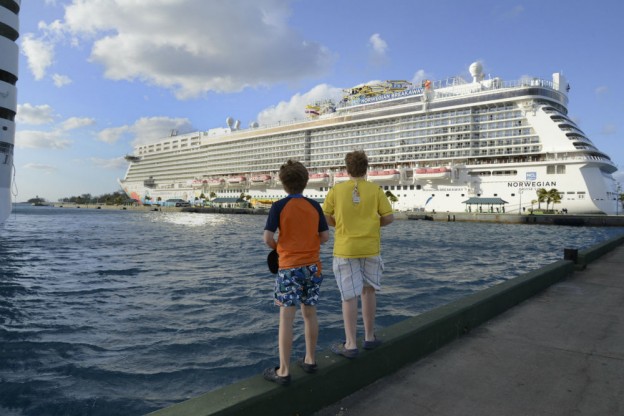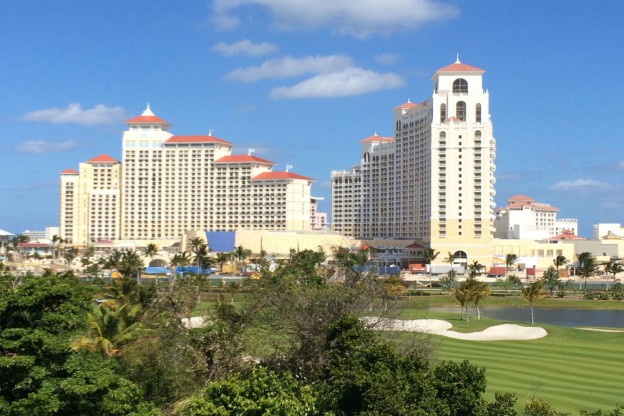The U.S. Virgin Islands, Antigua and Barbuda, and St. Lucia will reopen to U.S. travelers during the first few days of June, followed later this summer by Aruba and possibly the Bahamas. While large swaths of the world struggled with coronavirus outbreaks, many Caribbean islands were able to limit their number of COVID-19 cases and quickly contain community spread. Now, a few are preparing to get their tourism businesses back on track, with plenty of additional safety measures, of course.
Below are the opening plans, but keep in mind that the CDC still advises against all non-essential travel, and the U.S. State Department maintains a global level 4 “do not travel” alert. Also, flights to these islands are highly subject to change, warns Brett Snyder of Cranky Concierge.
Antigua and Barbuda
Open to travelers June 1
Status:
As of May 1, the islands of Antigua and Barbuda had seen only 25 cases between them and three deaths.
Travel requirements:
V.C. Bird International Airport on Antigua will reopen for international and regional flights on June 1. (The first flight scheduled flight from the U.S. so far is American Airline’s Miami–Antigua on June 4.)
When visitors land at the airport, they must show proof of a negative COVID-19 test taken within the previous 48 hours, complete a health declaration, and undergo temperature checks. They must also have their own masks to wear in all public areas during their stay. Anyone arriving without a certified negative test result must either quarantine at their hotel for 14 days or pay to have an approved test administered locally. Read the government’s full travel advisory.
Hotels and activities:
All accommodations (hotels, resorts, rentals, villas) and transportation operators must meet cleaning and safety protocols and be certified by the islands’ health authorities in order to resume service. For example, hotel employees have to live on-property in order to limit their possible exposure to the virus, and taxi drivers will be given time to wash their hands at hotels between passengers. Government updates are posted here.
Flights:
American: from Miami (June 4)
JetBlue: from JFK (July 1)
Delta: from Atlanta (July 4)
United: from Newark (July 11)
U.S. Virgin Islands
Open to travelers June 1
Status:
As of May 28, the US Virgin Islands had 69 cases of COVID-19 and six deaths. About two dozen more tests were in progress on that date.
Travel requirements:
Visitors to any of the U.S. Virgin Islands (St. Croix, St. John, and St. Thomas) will undergo temperature screenings and may be asked to take a COVID-19 test. No quarantine is mandated, but they are asked to monitor their health for 14 days.
Hotels and activities:
The USVI government is keeping a list of open hotels, and all accommodations (including rentals) are required to follow sanitization procedures.
Restaurants and bars will be open with seating restrictions (so call ahead), beaches are open with social distancing rules, and taxis will be available but operating at 50 percent seating capacity. A document outlining info for leisure travelers is being kept up-to-date on the USVI governor’s website.
Flights:
American: from Charlotte (starts June 4) and Miami (ongoing) to St. Thomas; from Miami to St. Croix (ongoing)
Delta: from Atlanta to St. Thomas (ongoing)
United: from Houston to St. Thomas (ongoing)
St. Lucia
Opens on June 4 to U.S. travelers arriving by air only
Status:
St. Lucia suffered only 18 cases of COVID-19, and all of them recovered. As a result, it’s ready to get back to tourism on June 4. The opening applies to air travel only (seaports remain closed) and to U.S. travelers only.
Travel requirements:
Travelers must show proof of a negative coronavirus test taken with 48 hours of boarding their flight. On arrival at the St. Lucia airport, there will be temperature screenings and luggage sanitization.
Hotels and activities:
About 1,500 hotel rooms are expected to be available, and each property must earn a COVID-19 certificate from the government before it can open. The process requires that they meet safety criteria in areas such as sanitization and social-distancing protocols. Guests can expect temperature screenings at meal times, limited-contact check-in/check-out, on-site nurse stations, physical distancing, limited services and activities, and they’ll only be able to use taxis booked by the hotel. Restaurants on the island will be open for take-out and delivery only, and your hotel can offer information on what activities are available. Once they’re on the island, visitors must wear masks in public, even in public areas of their accommodations. For a full explanation of all of St. Lucia’s rules and preparations, read the government’s helpful FAQ.
Flights:
American: from Miami (June 4)
JetBlue: from JFK (June 11)
Delta: from Atlanta (July 2)
United: from Newark (July 11)
Aruba
Tentative reopening expected between June 15 and July 1
Status:
As of May 29, Aruba has reported 101 cases, three deaths.
What we know:
Aruba’s government recently announced an intention to open sometime between June 15 and July 1. Once that date is finalized, they’ll provide more specifics about entry requirements, health-screening plans, and on-island safety protocols.
In the meantime, the Aruba Tourism Authority and the Department of Public Health have unveiled the Aruba Health & Happiness Code, a cleanliness-and-safety certification for tourism-related businesses and accommodations.
Flights:
Since the island’s official opening date is not yet set, this flight information is all tentative.
American: from Charlotte and Miami (July 7)
JetBlue: from Boston, Ft. Lauderdale, and JFK (July 1)
Delta: from Atlanta (July 5)
United: from Newark (July 6); from Chicago/O’Hare, Washington-Dulles and Houston-Intercontinental (July 11)
Bahamas
Possible opening July 1, according to Prime Minister Dr. Hubert Minnis
Flights to Nassau:
JetBlue: from Ft Lauderdale (June 11); from JFK and Orlando (July 1)
Delta: from Atlanta (July 1)
Southwest: from Baltimore (July 1)
American: from Charlotte and Miami (July 7)
United: from Newark and Houston (July 6); from Chicago and Denver (July 11)
Be a safer, smarter traveler: Sign up for Wendy’s weekly newsletter to stay in the know. And read real travelers’ reviews of Wendy’s WOW List and use it to plan your next trip.










